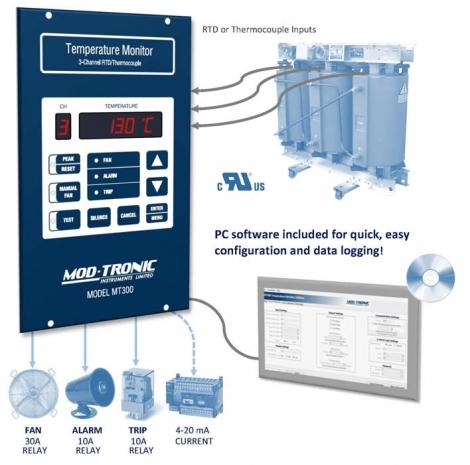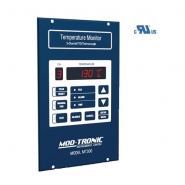The MT300 transformer monitor provides users a completely programmable transformer temperature monitor and alarm with improved measurement range of -50°C to 300°C (-58°F to 572°F) and universal inputs of either 100Ω or 1000Ω Platinum RTDs or Types E or K thermocouples. The microprocessor-based design maintains accuracy over a wide range of temperatures and conducts regular self-checks to ensure correct operation. Additionally, one of the relay outputs is specifically designed for control of a cooling fan with a 30 Amp rating. The user-configurable fan exercise option extends the fan life and reduces bearing lock-up. The monitor is easily configured via MODBUS over a USB connection to your PC or MODBUS/RS-485 using the included PC software that also provides data logging.
Key features of micro-processor-based temperature transformer monitor:
- Universal inputs of 100 and 1000 Ω platinum RTDs and Types E and K thermocouples
- This transformer monitor is configurable through the front-panel interface, MODBUS over USB or the isolated RS-485, PC software included for data logging and configuration
- User-configurable measurement range to Celsius or Fahrenheit scale
- Large, dimmable 7-digit LED display allows easy programming and visibility at various distances and lighting conditions
- Dual password design allows certain users to have full configuration access and others, set points only Non-volatile memory storage of per-channel min/max temperatures for recall in the event of power-loss
- Electrically isolated 4-20mA output signal allows for connection to PLCs or remote displays
- UL/cUL recognition (MT300A and MT300B) and CE certification (MT300A)
- 5 Year Limited Warranty
MT300 Monitor Software Download Version 1.0
(Use only if the newer version 2.0 below doesn't work on your system)
MT300 Monitor Software Download Version 2.0
Introduction
The CT424 is a universal, three‐channel temperature monitor capable of utilizing any combination of the supported sensor types. Three relay outputs and an internal buzzer are individually configurable to be tripped by one or more sensor inputs. The included 4‐20mA output is fully configurable and may be loop powered or internally powered. An RS‐485 interface and USB port use the MODBUS protocol to configure the unit as well as read the configuration, sensor values, and peak values. However, all configuration and available values are accessible via the intuitive front panel interface. Celsius and Fahrenheit scales are supported. Separate electrical isolation is provided on the 4‐20mA loop, RS‐485, and sensor inputs for compatibility with a wide range of installation environments.
Conventions
Several different typestyles are used throughout this manual to make it easier to convey whether the text refers to a button, indicator, numeric display, output, etc. In general, if a word or phrase is in all caps (LIKE THIS) it means that it refers to the name of a button or single LED indicator on the CT424 front panel. Exceptions to this are acronyms such as USB and MODBUS. If a word or phrase is first letter capitalized (Like This) it means that it refers to the name of a feature, such as Fan Exerciser, or an input or output, such as Channel 1 or Fan Relay. If a word or phrase is in an LED display font () it means that it refers to something displayed on the numeric display. If a value is preceded by “0x”, that value is in hexadecimal; other numbers should be assumed to be decimal. The usage of the words “alarm” and “trip”, in particular, regardless of capitalization, could be confusing. These two words are industry standard terms for relay outputs on products such as the CT424. Alarm could refer to the Alarm Relay output, front panel ALARM indicator, or the audible alarm (Buzzer). However, when referring to the relay output, it is explicitly written as such. When referring to the front panel indicator, capitalization will be used as previously described to prevent confusion. Trip can refer to the Trip Relay output, the front panel TRIP indicator, the action of a setpoint being exceeded, or describing the group of settings that determine a setpoint, and what happens when that setpoint is exceeded, which is referred to as “trip settings”. Again, the previously described convention will be used to clarify the intended meaning. Because of the Reverse Acting Relay feature, specific terms are used to indicate whether a relay’s coil is actually powered, or if that relay output is in the trip state regardless of the Reverse Acting Relay settings. If referring to whether a relay’s coil is powered, “energize” will be used. If referring to if a relay output is in the trip state, “engage” will be used. If a relay output is engaged, the associated front panel LED will light, however, whether the relay is energized will depend on the Reverse Acting Relay settings.
What is a dry-type transformer temperature monitor, and why is it important?
A dry-type transformer temperature monitor is a device designed to monitor and track the temperature of a dry-type transformer's windings and core. It ensures the transformer operates within safe temperature limits, preventing overheating, which can lead to reduced efficiency, insulation damage, or even transformer failure.
How does a dry-type transformer temperature monitor work?
The transformer monitor uses temperature sensors, typically installed in the transformer's windings or near the core, to continuously measure transformer heat levels. These sensors relay data to the monitor, which displays the readings and can trigger alarms or protective actions if the temperature exceeds predefined thresholds.
Can a temperature monitor extend the lifespan of a dry-type transformer?
Yes a temperature monitor can maximize the longevity of a transformer, by continuously monitoring the temperature and alerting operators to potential transformer overheating issues. A temperature monitor helps maintain optimal transformer operating conditions. This proactive approach reduces wear and tear, prevents insulation degradation, and extends the transformer's service life.
Is a transformer temperature monitor difficult to install?
Transformer monitor installation typically involves placing temperature sensors in the transformer and connecting them to the monitor. While straightforward for experienced monitor transformer technicians, it’s recommended to follow the manufacturer’s instructions or consult a professional to ensure proper setup and accurate transformer monitor readings.
A company utility meter for the grid monitor with IOT can fault on moisture and tank in real-time. A distribution transformer monitor for gas technologies or hydrogen can high voltage partial discharge.










